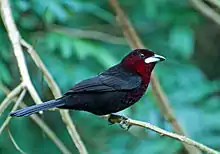Ramphocelus
Ramphocelus is a Neotropical genus of birds of the tanager family. They have enlarged shiny whitish or bluish-grey lower mandibles, which are pointed upwards in display. However, this is greatly reduced in the females of most species. Males are black and red, orange or yellow, while females resemble a duller version of the males, or are brownish or greyish combined with dull red, orange or yellowish.
| Ramphocelus | |
|---|---|
 | |
| Brazilian tanager (Ramphocelus bresilius) | |
| Scientific classification | |
| Kingdom: | Animalia |
| Phylum: | Chordata |
| Class: | Aves |
| Order: | Passeriformes |
| Family: | Thraupidae |
| Genus: | Ramphocelus Desmarest, 1805 |
| Type species | |
| Tanagra brasilia Linnaeus, 1766 | |
| Species | |
|
See species list | |
Ramphocelus tanagers are found in semi-open areas. The nest is a cup built by the female of plant materials such as moss, rootlets, and strips of large leaves like banana or Heliconia, and is often in a fairly open site in a tree. The female usually lays pale blue eggs, with grey, brown or lavender spots, and the young stay in the nest for only about 12 days.
The songs of this genus are repetitions of rich one- or two-syllable whistles.
Ramphocelus tanagers hunt at forest edges or in second growth, taking insects in flight or picking them from leaves.
Taxonomy
The genus Ramphocelus was introduced by the French zoologist Anselme Gaëtan Desmarest in 1805.[1] The name combines the Ancient Greek words rhamphos "bill" and koilos "concave".[2] The type species was designated as the Brazilian tanager by the English zoologist George Robert Gray in 1855.[3][4]
The other species form two superspecies. One includes crimson-backed, Huallaga, silver-beaked and Brazilian tanagers, and the other comprises Passerini's, Cherrie's and flame-rumped tanagers.
The subspecies icteronotus of the flame-rumped tanager is sometimes considered a separate species, and the lemon-rumped tanager, R. icteronotus, and Passerini's and Cherrie's tanager were formerly lumped as scarlet-rumped tanager, R. passerinii (a treatment some authorities still prefer).
Species in taxonomic order
The genus contains nine species:[5]
| Image | Scientific name | Common Name | Distribution |
|---|---|---|---|
 | Ramphocelus sanguinolentus | Crimson-collared tanager | southern Veracruz and northern Oaxaca in Mexico through the Atlantic slope of Central America,western Panama |
.jpg.webp) | Ramphocelus nigrogularis | Masked crimson tanager | Bolivia, Brazil, Colombia, Ecuador, and Peru |
.jpg.webp) | Ramphocelus dimidiatus | Crimson-backed tanager | Colombia, Panama, and Venezuela, and introduced to French Polynesia |
| Ramphocelus melanogaster | Huallaga tanager | Peru | |
 | Ramphocelus carbo | Silver-beaked tanager | South America from eastern Colombia and Venezuela south to Paraguay and central Brazil, Perú and on Trinidad |
 | Ramphocelus bresilius | Brazilian tanager | eastern Brazil and far northeastern Argentina |
.jpg.webp) | Ramphocelus passerinii | Scarlet-rumped tanager | Caribbean lowlands from southern Mexico to western Panama |
.jpg.webp) | Ramphocelus flammigerus | Flame-rumped tanager | Tumbes-Chocó-Magdalena in Panama, Colombia, Ecuador and Peru |
.jpg.webp) | Ramphocelus icteronotus | Lemon-rumped tanager | Panama to Ecuador |
References
- Desmarest, Anselme Gaëtan (1805). Histoire naturelle des Tangaras, des Manakins et des Todiers (in French). Paris: Imprimarie de H. Perronneau. Plate 28 text.
- Jobling, James A. (2010). The Helm Dictionary of Scientific Bird Names. London: Christopher Helm. p. 330. ISBN 978-1-4081-2501-4.
- Gray, George Robert (1855). Catalogue of the Genera and Subgenera of Birds Contained in the British Museum. London: British Museum. p. 148.
- Paynter, Raymond A. Jr, ed. (1970). Check-List of Birds of the World. Volume 13. Cambridge, Massachusetts: Museum of Comparative Zoology. p. 310.
- Gill, Frank; Donsker, David, eds. (2018). "Tanagers and allies". World Bird List Version 8.1. International Ornithologists' Union. Retrieved 2 April 2018.
Sources
- ffrench, Richard (1991). A Guide to the Birds of Trinidad and Tobago (2nd ed.). Comstock Publishing. ISBN 0-8014-9792-2.
- Hilty, Birds of Venezuela, ISBN 0-7136-6418-5
- Morton, Isler & Isler, Tanagers ISBN 0-7136-5116-4
- Stiles and Skutch, A guide to the birds of Costa Rica ISBN 0-8014-9600-4
- Steve N. G. Howell and Sophie Webb (1995). A Guide to the Birds of Mexico and Northern Central America. Oxford University Press. ISBN 0-19-854012-4.
- S. J. Hackett (1996). "Molecular phylogenetics and biogeography of tanagers in the genus Ramphocelus (Aves)". Molecular Phylogenetics and Evolution. 5 (2): 368–382. doi:10.1006/mpev.1996.0032. PMID 8728395.